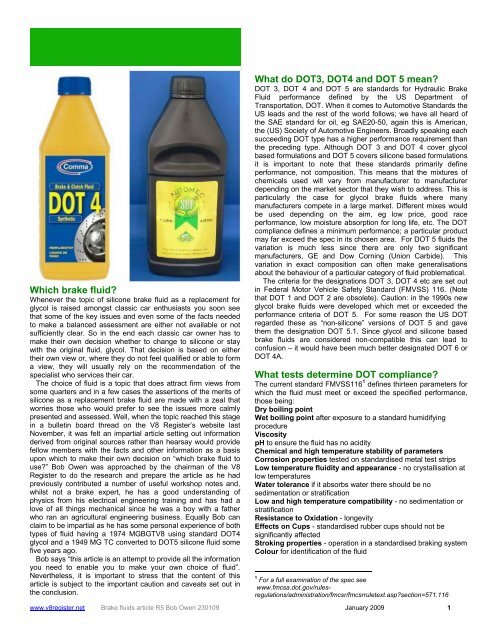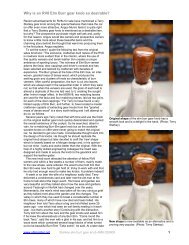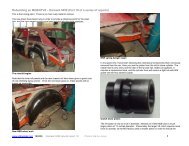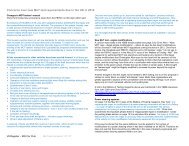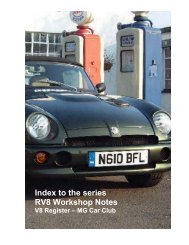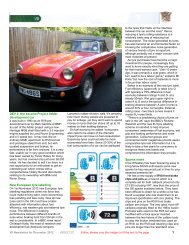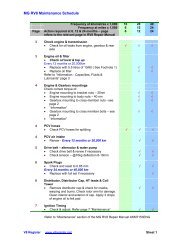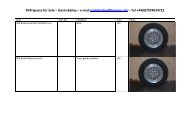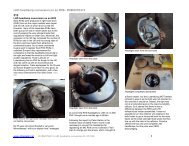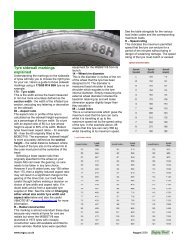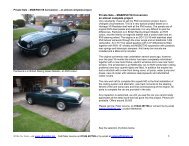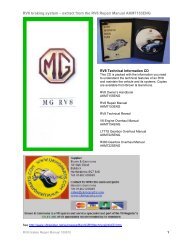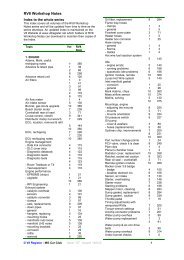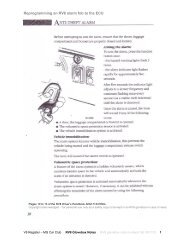Which brake fluid? What do DOT3, DOT4 and DOT 5 ... - V8 Register
Which brake fluid? What do DOT3, DOT4 and DOT 5 ... - V8 Register
Which brake fluid? What do DOT3, DOT4 and DOT 5 ... - V8 Register
Create successful ePaper yourself
Turn your PDF publications into a flip-book with our unique Google optimized e-Paper software.
<strong>Which</strong> <strong>brake</strong> <strong>fluid</strong>?<br />
Whenever the topic of silicone <strong>brake</strong> <strong>fluid</strong> as a replacement for<br />
glycol is raised amongst classic car enthusiasts you soon see<br />
that some of the key issues <strong>and</strong> even some of the facts needed<br />
to make a balanced assessment are either not available or not<br />
sufficiently clear. So in the end each classic car owner has to<br />
make their own decision whether to change to silicone or stay<br />
with the original <strong>fluid</strong>, glycol. That decision is based on either<br />
their own view or, where they <strong>do</strong> not feel qualified or able to form<br />
a view, they will usually rely on the recommendation of the<br />
specialist who services their car.<br />
The choice of <strong>fluid</strong> is a topic that <strong>do</strong>es attract firm views from<br />
some quarters <strong>and</strong> in a few cases the assertions of the merits of<br />
silicone as a replacement <strong>brake</strong> <strong>fluid</strong> are made with a zeal that<br />
worries those who would prefer to see the issues more calmly<br />
presented <strong>and</strong> assessed. Well, when the topic reached this stage<br />
in a bulletin board thread on the <strong>V8</strong> <strong>Register</strong>’s website last<br />
November, it was felt an impartial article setting out information<br />
derived from original sources rather than hearsay would provide<br />
fellow members with the facts <strong>and</strong> other information as a basis<br />
upon which to make their own decision on “which <strong>brake</strong> <strong>fluid</strong> to<br />
use?” Bob Owen was approached by the chairman of the <strong>V8</strong><br />
<strong>Register</strong> to <strong>do</strong> the research <strong>and</strong> prepare the article as he had<br />
previously contributed a number of useful workshop notes <strong>and</strong>,<br />
whilst not a <strong>brake</strong> expert, he has a good underst<strong>and</strong>ing of<br />
physics from his electrical engineering training <strong>and</strong> has had a<br />
love of all things mechanical since he was a boy with a father<br />
who ran an agricultural engineering business. Equally Bob can<br />
claim to be impartial as he has some personal experience of both<br />
types of <strong>fluid</strong> having a 1974 MGBGT<strong>V8</strong> using st<strong>and</strong>ard <strong><strong>DOT</strong>4</strong><br />
glycol <strong>and</strong> a 1949 MG TC converted to <strong>DOT</strong>5 silicone <strong>fluid</strong> some<br />
five years ago.<br />
Bob says “this article is an attempt to provide all the information<br />
you need to enable you to make your own choice of <strong>fluid</strong>”.<br />
Nevertheless, it is important to stress that the content of this<br />
article is subject to the important caution <strong>and</strong> caveats set out in<br />
the conclusion.<br />
<strong>What</strong> <strong>do</strong> <strong><strong>DOT</strong>3</strong>, <strong><strong>DOT</strong>4</strong> <strong>and</strong> <strong>DOT</strong> 5 mean?<br />
<strong>DOT</strong> 3, <strong>DOT</strong> 4 <strong>and</strong> <strong>DOT</strong> 5 are st<strong>and</strong>ards for Hydraulic Brake<br />
Fluid performance defined by the US Department of<br />
Transportation, <strong>DOT</strong>. When it comes to Automotive St<strong>and</strong>ards the<br />
US leads <strong>and</strong> the rest of the world follows; we have all heard of<br />
the SAE st<strong>and</strong>ard for oil, eg SAE20-50, again this is American,<br />
the (US) Society of Automotive Engineers. Broadly speaking each<br />
succeeding <strong>DOT</strong> type has a higher performance requirement than<br />
the preceding type. Although <strong>DOT</strong> 3 <strong>and</strong> <strong>DOT</strong> 4 cover glycol<br />
based formulations <strong>and</strong> <strong>DOT</strong> 5 covers silicone based formulations<br />
it is important to note that these st<strong>and</strong>ards primarily define<br />
performance, not composition. This means that the mixtures of<br />
chemicals used will vary from manufacturer to manufacturer<br />
depending on the market sector that they wish to address. This is<br />
particularly the case for glycol <strong>brake</strong> <strong>fluid</strong>s where many<br />
manufacturers compete in a large market. Different mixes would<br />
be used depending on the aim, eg low price, good race<br />
performance, low moisture absorption for long life, etc. The <strong>DOT</strong><br />
compliance defines a minimum performance; a particular product<br />
may far exceed the spec in its chosen area. For <strong>DOT</strong> 5 <strong>fluid</strong>s the<br />
variation is much less since there are only two significant<br />
manufacturers, GE <strong>and</strong> Dow Corning (Union Carbide). This<br />
variation in exact composition can often make generalisations<br />
about the behaviour of a particular category of <strong>fluid</strong> problematical.<br />
The criteria for the designations <strong>DOT</strong> 3, <strong>DOT</strong> 4 etc are set out<br />
in Federal Motor Vehicle Safety St<strong>and</strong>ard (FMVSS) 116. (Note<br />
that <strong>DOT</strong> 1 <strong>and</strong> <strong>DOT</strong> 2 are obsolete). Caution: in the 1990s new<br />
glycol <strong>brake</strong> <strong>fluid</strong>s were developed which met or exceeded the<br />
performance criteria of <strong>DOT</strong> 5. For some reason the US <strong>DOT</strong><br />
regarded these as “non-silicone” versions of <strong>DOT</strong> 5 <strong>and</strong> gave<br />
them the designation <strong>DOT</strong> 5.1. Since glycol <strong>and</strong> silicone based<br />
<strong>brake</strong> <strong>fluid</strong>s are considered non-compatible this can lead to<br />
confusion – it would have been much better designated <strong>DOT</strong> 6 or<br />
<strong>DOT</strong> 4A.<br />
<strong>What</strong> tests determine <strong>DOT</strong> compliance?<br />
The current st<strong>and</strong>ard FMVSS116 1 defines thirteen parameters for<br />
which the <strong>fluid</strong> must meet or exceed the specified performance,<br />
those being:<br />
Dry boiling point<br />
Wet boiling point after exposure to a st<strong>and</strong>ard humidifying<br />
procedure<br />
Viscosity<br />
pH to ensure the <strong>fluid</strong> has no acidity<br />
Chemical <strong>and</strong> high temperature stability of parameters<br />
Corrosion properties tested on st<strong>and</strong>ardised metal test strips<br />
Low temperature <strong>fluid</strong>ity <strong>and</strong> appearance - no crystallisation at<br />
low temperatures<br />
Water tolerance if it absorbs water there should be no<br />
sedimentation or stratification<br />
Low <strong>and</strong> high temperature compatibility - no sedimentation or<br />
stratification<br />
Resistance to Oxidation - longevity<br />
Effects on Cups - st<strong>and</strong>ardised rubber cups should not be<br />
significantly affected<br />
Stroking properties - operation in a st<strong>and</strong>ardised braking system<br />
Colour for identification of the <strong>fluid</strong><br />
1 For a full examination of the spec see<br />
www.fmcsa.<strong>do</strong>t.gov/rulesregulations/administration/fmcsr/fmcsrruletext.asp?section=571.116<br />
www.v8register.net Brake <strong>fluid</strong>s article R5 Bob Owen 230109 January 2009 1
Some of the tests are <strong>do</strong>ne on the <strong>fluid</strong> itself <strong>and</strong> others use a<br />
st<strong>and</strong>ardised <strong>brake</strong> test rig using drum <strong>brake</strong>s with 28mm<br />
internal diameter wheel cylinders (the rig is defined by SAE J<br />
1703 Nov 83). Further explanations of some of the tests are<br />
given below. Some figures from the spec are shown here:<br />
Dry Boiling<br />
Point, min<br />
Wet Boiling<br />
Point, min<br />
Viscosity max<br />
At -40C<br />
<strong>DOT</strong> 3 <strong>DOT</strong> 4 <strong>DOT</strong> 5 <strong>DOT</strong> 5.1<br />
205C<br />
140C<br />
1500<br />
mm 2 /s<br />
230C<br />
155C<br />
1800<br />
mm 2 /s<br />
260C<br />
180C<br />
900<br />
mm 2 /s<br />
260C<br />
180C<br />
900<br />
mm 2 /s<br />
High boiling point is important in dem<strong>and</strong>ing braking<br />
situations where the <strong>brake</strong>s are generating great quantities of<br />
heat. If the <strong>fluid</strong> boils it turns into a gas <strong>and</strong> gases are very<br />
compressible – not a feature you want in a hydraulic braking<br />
system.<br />
For the wet boiling point test the humidification process<br />
exposes the <strong>fluid</strong> being tested <strong>and</strong> a st<strong>and</strong>ardised SAE glycol<br />
<strong>brake</strong> <strong>fluid</strong> to the same humidification process until the SAE <strong>fluid</strong><br />
reaches a water content of 3.7% by weight. This illustrates one of<br />
the weakest features of glycol based <strong>fluid</strong>s – they are<br />
hygroscopic, ie will readily absorb water. The presence of water<br />
significantly lowers the boiling point of the <strong>fluid</strong> resulting in a<br />
reduction in braking capability. For this reason glycol <strong>fluid</strong>s<br />
should only be used for 1 to 2 years before being replaced with<br />
fresh <strong>fluid</strong>. One of the major advantages of silicone <strong>fluid</strong> is that it<br />
<strong>do</strong>es not absorb water <strong>and</strong> so can be left in a braking system for<br />
much longer, typically ten times as long.<br />
A low viscosity is important to give responsive braking<br />
operation – quick on, quick off; you <strong>do</strong>n’t want your <strong>brake</strong> pedal<br />
to feel like a caulking gun. And it would not be a good idea to<br />
have <strong>brake</strong> <strong>fluid</strong> that froze! The low viscosity of silicone <strong>fluid</strong> is an<br />
advantage, especially in very cold conditions. In fact it will<br />
operate <strong>do</strong>wn to –50C.<br />
The next parameter that warrants some discussion is “Effects<br />
on Cups”. This is an area where <strong>DOT</strong> 5 <strong>fluid</strong>s have been<br />
reported to give problems <strong>and</strong> indeed I have had personal<br />
experience of seal expansion with <strong>DOT</strong> 5. My MG TC was<br />
converted to silicone by the previous owner about five years ago;<br />
two years ago I had problems with <strong>brake</strong>s binding <strong>and</strong> this turned<br />
out to be due to expansion of the Master Cylinder rubber seal.<br />
The exp<strong>and</strong>ed rubber blocked the <strong>fluid</strong> return drilling which<br />
should be exposed when the pedal is at rest, consequently the<br />
<strong>fluid</strong> pressure was not released <strong>and</strong> the <strong>brake</strong>s stayed partly on.<br />
The cure was to turn 0.7mm off the master cylinder piston. Yet<br />
silicone <strong>fluid</strong> is widely used in TCs <strong>and</strong> other classics with only a<br />
small proportion having any problem. As pointed out by Robin<br />
Gell in one of his emails, the chief unknown here is the<br />
composition of the rubber in the seals as <strong>DOT</strong> 5 <strong>fluid</strong> composition<br />
is closely defined <strong>and</strong> most available in the UK comes from a<br />
single supplier – Automec 2 ). The rubber defined by the st<strong>and</strong>ard<br />
is Styrene-butadiene Rubber (SBR) according to the following<br />
formulation:<br />
2 Automec Equipment <strong>and</strong> Parts Ltd, 36 Ballmoor, Buckingham, MK18<br />
1RQ Tel: 01280 822818, www.automec.co.uk<br />
Ingredient Parts by weight<br />
SBR type 1503 (or Philprene 1503) 100<br />
Oil furnace black (NBS 378) 40<br />
Zinc oxide (NBS 370) 5<br />
Sulphur (NBS 371) 0.25<br />
Stearic Acid (NBS 372) 1<br />
n-tertiary butyl-2-benzothiazole<br />
sulphenamide (NBS 384)<br />
1<br />
Symmetrical dibetanaphythyl-pphenylenediamine<br />
1.5<br />
Dicumyl peroxide (40 percent on<br />
precipitated CaCO3)<br />
4.5<br />
Total 153.25<br />
But how <strong>do</strong> we know that our often “anonymous” rubber seals,<br />
that are available as individual replacement parts or incorporated<br />
in replacement master <strong>and</strong> slave cylinders or servos, were made<br />
to this formulation? Victor Smith contacted Brovex Nelson 3 , a<br />
leading UK seal <strong>and</strong> <strong>brake</strong> hose manufacturer, <strong>and</strong> they<br />
confirmed that their seals will work well with either glycol or<br />
silicone <strong>fluid</strong>s. Unfortunately Brovex Nelson <strong>do</strong> not put their name<br />
or trade mark on their seals, just the legend “Made in Engl<strong>and</strong>”. In<br />
addition there are three or four code letters or numbers on their<br />
seals which define their type numbers. We have learnt to be<br />
suspicious of aftermarket parts of unknown origin, especially<br />
those originating in India or China, so the “Made in Engl<strong>and</strong>”<br />
legend may at least give some reassurance.<br />
FMVSS116 uses st<strong>and</strong>ardised test cups of 28mm diameter<br />
with the above rubber composition <strong>and</strong> specifies the limits of<br />
physical change in terms of maximum <strong>and</strong> minimum expansion,<br />
maximum change in hardness, guminess, carbonisation <strong>and</strong><br />
stickiness over prolonged stroking testing on the st<strong>and</strong>ardised<br />
test <strong>brake</strong> rig (see “Stroking properties” below).<br />
Note that minimum expansion is specified; this is very<br />
significant. Obviously you <strong>do</strong>n’t want your seals to shrink <strong>and</strong> for<br />
this reason FMVSS116 defines a minimum expansion of 0.15mm<br />
(the maximum expansion is 1.4mm). The minimum expansion<br />
requirement is not a problem for glycol <strong>fluid</strong>s which naturally<br />
cause the specified rubber to exp<strong>and</strong>. In fact they may cause<br />
excessive expansion in some rubbers not made to the FMVSS<br />
spec. For example, there are many US bulletin board postings<br />
concerning problems with L<strong>and</strong>rovers when using <strong>DOT</strong> 3 <strong>fluid</strong>s.<br />
The stated cure is either to use <strong>DOT</strong> 4 <strong>fluid</strong>s or fit American seals.<br />
Yet in the UK there are no reports of problems with <strong>DOT</strong> 3 <strong>fluid</strong>s,<br />
again an indication that the glycol <strong>fluid</strong>s are made to different<br />
formulations <strong>and</strong> that <strong>DOT</strong> ratings are performance minima, not<br />
composition requirements. (Some trans-Atlantic fun is had by our<br />
American friends claiming that the Brits use more natural rubber<br />
in their seal formulations in an attempt to support the former<br />
empire in the form of the Malaysian rubber plantations.)<br />
Bearing in mind the oft cited mantra that silicone <strong>fluid</strong>s exp<strong>and</strong><br />
rubber seals, it is ironic to learn that basic diorgano-polysiloxane<br />
(silicone) <strong>brake</strong> <strong>fluid</strong>s in fact cause the st<strong>and</strong>ard American seals<br />
to shrink, so failing the <strong>DOT</strong> tests. Silicone <strong>brake</strong> <strong>fluid</strong>s were first<br />
patented in 1946 by McGregor et al 4 with advantages cited as<br />
near constant viscosity over temperature, low freezing point, high<br />
flash point, low hygroscopicity, <strong>and</strong> low corrosivity or other effects<br />
3 Brovex Nelson Ltd, Highfield Road, Camelford, Cornwall, PL32 9RA<br />
Tel:01840213711 pchapman.nelsons@virgin.net<br />
4 US patent 2398187, April 1946<br />
www.v8register.net Brake <strong>fluid</strong>s article R5 Bob Owen 230109 January 2009 2
on metal <strong>and</strong> rubbers. However, early formulations caused<br />
leaching of the plasticizers from the rubber seals, so shrinking<br />
them. To counteract this, rubber swell additives, such as di (2thylhexyl)<br />
azelate or tributyl phosphate are added at 1% to 5% by<br />
weight to achieve the required swell 5 . This, <strong>and</strong> other<br />
improvements in lubricity <strong>and</strong> other characteristics developed<br />
over time, eventually resulted in the <strong>DOT</strong>5 st<strong>and</strong>ard, published<br />
by FMVSS in Oct 1974.<br />
The somewhat dubious sounding “Stroking Properties” test<br />
covers practical performance in a st<strong>and</strong>ardised <strong>brake</strong> test rig.<br />
This uses three single leading shoe drum <strong>brake</strong>s with 28mm<br />
diameter wheel cylinder pistons <strong>and</strong> a master cylinder with 28mm<br />
diameter piston <strong>and</strong> st<strong>and</strong>ardised components throughout as<br />
defined in SAE J 1703. The tests consist of repeated “stroking” to<br />
a pressure of 1000psi repeated at a rate of 1000 strokes per<br />
hour with the whole assembly in a thermostatically controlled<br />
oven. Stroking is carried out at 23C <strong>and</strong> 120C over a total of<br />
85,000 strokes. The pistons <strong>and</strong> seals are then examined for<br />
wear <strong>and</strong> physical changes <strong>and</strong> the loss of <strong>fluid</strong> is checked. If<br />
these are within the prescribed limits the <strong>DOT</strong> rating is achieved.<br />
So a <strong>DOT</strong> 5 <strong>fluid</strong> can only be certified <strong>DOT</strong> 5 if it has no<br />
significantly deleterious effect on rubber seals complying<br />
with the <strong>DOT</strong> 5 specified formulation.<br />
The Colour specification is not necessarily a natural feature of<br />
the <strong>fluid</strong> formulations but is a requirement of the <strong>DOT</strong> st<strong>and</strong>ards<br />
to allow identification. Non-silicone <strong>fluid</strong>s, ie <strong>DOT</strong> 3, <strong>DOT</strong> 4 <strong>and</strong><br />
<strong>DOT</strong> 5.1 should be colourless to amber. <strong>DOT</strong> 5, silicone <strong>fluid</strong>s,<br />
should be purple.<br />
Note that a third category of <strong>brake</strong> <strong>fluid</strong>s exists – mineral <strong>fluid</strong>s.<br />
These are used in some Citroens, Rolls Royces, Audis <strong>and</strong><br />
Jaguars. These systems use pressurised oils in systems that<br />
have no SBR compounds. These <strong>fluid</strong>s are coloured green.<br />
A safe maxim is that different coloured <strong>brake</strong> <strong>fluid</strong>s should<br />
not be mixed.<br />
<strong>What</strong> <strong>do</strong>es <strong>DOT</strong> compliance not tell us?<br />
Because of history, the <strong>DOT</strong> tests are geared towards examining<br />
glycol <strong>fluid</strong>s <strong>and</strong> so focus on the known weaknesses of glycol<br />
<strong>fluid</strong>s, such as water absorption. Some important parameters that<br />
FMVSS116 <strong>do</strong>es not cover are: compressibility, air absorption,<br />
effect on braking components if left inactive for long periods,<br />
ease of bleeding, miscibility with other <strong>fluid</strong>s, flammability, effect<br />
on automotive paint finishes, environmental impact, initial cost<br />
<strong>and</strong> through life cost.<br />
The compressibility of a <strong>fluid</strong> is very small but is finite. In a<br />
hydraulic <strong>brake</strong> system the <strong>fluid</strong> is ideally uncompressible so that<br />
there is minimum loss of pedal travel <strong>and</strong> maximum feel of the<br />
<strong>brake</strong>s. Silicone <strong>fluid</strong>s are less dense than glycol <strong>fluid</strong>s <strong>and</strong> so<br />
are inherently more compressible. At 25C a pressure of 1000psi<br />
will cause a less than 1% reduction in volume. At 260C the<br />
reduction will be less than 3%. 6 However, of more significance<br />
than basic compressibility is air absorption. Absorbed air<br />
increases the compressibility of the <strong>fluid</strong>. Generally less dense<br />
<strong>fluid</strong>s have more air absorption <strong>and</strong> in fact silicone <strong>fluid</strong>s have<br />
substantially more air absorption than glycol <strong>fluid</strong>s. This is all a<br />
matter of degree <strong>and</strong> the compressibility of silicone under normal<br />
braking conditions is not significant. The elasticity of st<strong>and</strong>ard<br />
<strong>brake</strong> hoses will be just as important a contributor to pedal travel.<br />
However, for racing, with extreme braking conditions <strong>and</strong><br />
5 Information from US patent 4640792, March 1987, Dow Corning.<br />
6 http://www.clearcoproducts.com/silicones_library.html#1<br />
when maximum <strong>brake</strong> feel is required, the high temperature<br />
compressibility of silicone makes it compare unfavourably<br />
with <strong>DOT</strong>5.1 or other special racing glycols.<br />
In my own experience my TC pedal is very firm despite using<br />
silicone <strong>fluid</strong> <strong>and</strong> remains so under pretty arduous braking, as for<br />
example experienced on the Alpine passes descended during the<br />
MG Car Club Event of the Year in Switzerl<strong>and</strong> in 2008. My <strong>V8</strong><br />
uses glycol <strong>and</strong> yet has a more spongy pedal than the TC; but<br />
this is not due to the <strong>fluid</strong> but to the different braking system <strong>and</strong><br />
at least partly due to the remote servo set up of the <strong>V8</strong>. A remote<br />
servo is activated by the displacement under pressure of an<br />
activating piston <strong>and</strong> so must of necessity result in increased<br />
pedal travel compared to a direct system. I have not driven my TC<br />
with glycol <strong>fluid</strong> so cannot compare, but Malcolm Sayers says that<br />
the slight increase in sponginess present on his TC when he<br />
converted to silicone was more than counteracted by fitting<br />
Goodrich reinforced flexible hoses 7 . I have given these non<br />
quantified accounts to give an idea of the degree of sponginess<br />
that can be expected using <strong>DOT</strong> 5 under non-racing conditions.<br />
Another characteristic of <strong>fluid</strong>s with dissolved air is that abrupt<br />
changes of pressure can result in the release of air bubbles into<br />
the <strong>fluid</strong>, an effect similar to having a poorly bled system. These<br />
abrupt changes can occur in ABS valves <strong>and</strong> this is, I believe,<br />
why <strong>DOT</strong> 5 <strong>fluid</strong> is not recommended for use in vehicles fitted<br />
with ABS. However, this is unlikely to be relevant to classic cars.<br />
Effect on braking components if left inactive for long<br />
periods. Silicone <strong>fluid</strong>s are definitely an advantage in situations<br />
where a braking system may be inactive for some time, say<br />
several months or more. This is often the case with classic cars<br />
that may be taken off the road for the winter. It is also often the<br />
case with military or other service vehicles which may be<br />
“mothballed” <strong>and</strong> is no <strong>do</strong>ubt one of the major factors that led to<br />
its a<strong>do</strong>ption by the US Military (see later). Glycol based systems<br />
are prone to produce sticking wheel cylinders under these<br />
conditions due to moisture ingress through the boots causing the<br />
<strong>fluid</strong> to become corrosive. Although there are other conditions<br />
caused by lack of use, this one is amongst the most troublesome.<br />
To avoid it <strong>and</strong> the others (eg sticking SU fuel pump contacts), I<br />
try to use my <strong>V8</strong> at least every three weeks throughout the year.<br />
The silicone <strong>brake</strong>d TC remains unused for intervals of three<br />
months or more over the winter <strong>and</strong> I’ve never had any <strong>brake</strong><br />
problems from this.<br />
Malcolm Sayers started his classic car rebuilds fifteen years<br />
ago with a 1930s Morris Minor. He used st<strong>and</strong>ard glycol <strong>fluid</strong> in<br />
the braking system <strong>and</strong> every spring had to dismantle <strong>and</strong> hone<br />
the wheel cylinders to get it to work. Next he had a 1937 Morris 8<br />
<strong>and</strong> had the same problem. He changed to silicone <strong>and</strong> the<br />
problems disappeared. Subsequently he’s restored a TD <strong>and</strong> a<br />
TC <strong>and</strong> has used silicone <strong>fluid</strong> in both with no problems.<br />
Incidentally, he’s never experienced any problem with swelling<br />
rubber seals. Numerous other classic car owners have had no<br />
problems with silicone amongst whom are those who contributed<br />
to the original <strong>V8</strong> Bulletin Board thread including Robin Gell (his<br />
classic L<strong>and</strong>rover <strong>and</strong> also the MG TA belonging to his brother)<br />
<strong>and</strong> Paul Gill in his MGBGT<strong>V8</strong> with the same <strong>fluid</strong> <strong>and</strong> seals since<br />
1990 having covered 35,000 miles.<br />
Ease of bleeding is a characteristic where glycol has the edge.<br />
The air absorption behaviour of silicone means that you can get a<br />
persistence of fine bubbles in the <strong>fluid</strong>. It is common to hear<br />
people say that they needed to bleed their silicone system twice<br />
7 http://www.goodridge.net/uk/automotive.htm<br />
www.v8register.net Brake <strong>fluid</strong>s article R5 Bob Owen 230109 January 2009 3
efore it was right. I personally haven’t had much problem<br />
bleeding my TC but I would recommend using a Gunson’s<br />
Easibleed 8 . Don’t be worried by spending £15 on an Easibleed or<br />
about using a bit more <strong>fluid</strong> –after all, you’re saving £30 to £40<br />
by not paying someone else to bleed it for you! Moreover, you<br />
should not have to <strong>do</strong> it every one or two years as you would with<br />
a glycol system. I wonder if some people’s “sponginess”<br />
complaint with silicone is in fact <strong>do</strong>wn to inadequate bleeding but<br />
is put <strong>do</strong>wn by them to being simply that “well known<br />
characteristic” of the <strong>DOT</strong>5 <strong>fluid</strong>.<br />
Miscibility with other <strong>fluid</strong>s. All glycol <strong>fluid</strong>s are miscible,<br />
although if you mix them you will of course compromise<br />
performance towards the lowest common denominator. Glycol<br />
<strong>and</strong> silicone <strong>fluid</strong>s are immiscible in so far as they will not<br />
physically mix, silicone being lighter <strong>and</strong> so floating on top of the<br />
glycol. However, there is some disagreement about whether the<br />
presence of the two <strong>fluid</strong>s together in a braking system poses a<br />
problem. Of course, to get the full advantages of a given type<br />
you must have 100% of that <strong>fluid</strong> type. Some say that there is a<br />
chemical reaction between the two <strong>fluid</strong>s which causes braking<br />
problems <strong>and</strong> that, if changing from glycol to silicone, it is<br />
necessary to flush out the system with isopropyl alcohol <strong>and</strong> to<br />
change all the seals. I did a little experiment <strong>and</strong> put about 50cc<br />
of Comma <strong>DOT</strong> 4 <strong>and</strong> 50cc of Automec <strong>DOT</strong> 5 in a sealed jar<br />
<strong>and</strong> stored it for six weeks at room temperature. Initially the<br />
purple <strong>DOT</strong> 5 floated on top of the straw <strong>DOT</strong> 4, as expected.<br />
There was no apparent reaction. BUT, after the 6 weeks the <strong>DOT</strong><br />
5 had become colourless <strong>and</strong> the <strong>DOT</strong> 4 was dark purple 9.<br />
Clearly, if nothing else, the dyes in the two types had reacted.<br />
But whether any other more significant reaction had taken place,<br />
<strong>and</strong> whether the observed change was deleterious to<br />
performance, I could not say.<br />
Silicone (top) over Glycol <strong>fluid</strong><br />
(below) on Day 1<br />
Silicone (top) <strong>and</strong> glycol<br />
(below) on Day 40<br />
It is clear from FMVSS116 that <strong>DOT</strong> certified <strong>fluid</strong>s are<br />
compatible with rubber seals that themselves comply with the<br />
st<strong>and</strong>ard <strong>and</strong> so the same rubbers seals should work with either<br />
<strong>DOT</strong> 3, <strong>DOT</strong> 4 or <strong>DOT</strong> 5 <strong>fluid</strong>s.<br />
However, the st<strong>and</strong>ard says nothing about operation first with<br />
one type <strong>and</strong> then with another type. It is on this point that there<br />
are many warnings on various bulletin boards <strong>and</strong> auto blogs<br />
saying that you must change all seals. But there is precious little<br />
evidence about this or explanation for it. Of course, no one is<br />
going to get any blame for following what is clearly the path of<br />
least risk.<br />
8 Gunson, Kineton Road, Southam, Warks CV47 0DR Tel 01926 815000<br />
www.gunson.co.uk or many car tool shops<br />
9 This reminds me of a classic Tommy Cooper trick where he put a black<br />
h<strong>and</strong>kerchief <strong>and</strong> a white h<strong>and</strong>kerchief into a tube, intoned the magic<br />
words, then pulled out the white one that had turned black <strong>and</strong> the black<br />
one that had turned white…….<br />
Automec’s Jon Smith, in conversation with Robin Gell, said that<br />
over the last twenty years they have changed over many systems<br />
from glycol to silicone without flushing <strong>and</strong> changing seals <strong>and</strong><br />
that they have had no problems. They are supported in this by the<br />
US Military. Spurred by the advantages of silicone <strong>fluid</strong>s in terms<br />
of lower maintenance <strong>and</strong> the ability to operate after long periods<br />
of storage, the US Military produced MIL-B-46176 10 , a spec<br />
based on <strong>DOT</strong> 5 but requiring –50C operation <strong>and</strong> tighter rubber<br />
swelling, flashpoint <strong>and</strong> other limits. The <strong>DOT</strong> 5 manufacturers<br />
met this tighter spec <strong>and</strong> the US Army introduced a changeover<br />
programme that started in July 1981 <strong>and</strong> was completed by June<br />
1982. They refer to the silicone <strong>fluid</strong> as BFS (Brake Fluid,<br />
silicone) <strong>and</strong> issued the following changeover instructions 11:<br />
New non-tactical (commercial) vehicles/equipment received with<br />
polyglycol <strong>brake</strong> <strong>fluid</strong> will be replenished with BFS whenever<br />
<strong>brake</strong> <strong>fluid</strong> additions are required. These vehicles/equipment are<br />
to be retrofitted with BFS at the time of major <strong>brake</strong> system<br />
maintenance. Vehicles/equipment in depots will be converted to<br />
BFS prior to shipment.<br />
So clearly the US Army had no qualms about even topping up<br />
glycol based systems with silicone! I’ve found no subsequent<br />
<strong>do</strong>cument that counterm<strong>and</strong>s this one so can only assume all<br />
went well. Of course, people may have differing opinions on the<br />
competence of the US Army . . . . If you <strong>do</strong> decide to change from<br />
glycol to silicone <strong>and</strong> to follow the more cautious approach of<br />
flushing the system then use isopropanol (iso propyl alcohol or<br />
IPA) as the flushing agent as this is a volatile solvent that<br />
dissolves both glycol <strong>and</strong> silicone based <strong>fluid</strong>s <strong>and</strong> ideally follow<br />
up with a blow through with compressed air.<br />
Flammability. Glycol <strong>fluid</strong>s will burn more readily than silicone<br />
<strong>fluid</strong>s. A typical <strong><strong>DOT</strong>3</strong> <strong>fluid</strong> will have a flash point of around 80C<br />
<strong>and</strong> a typical <strong>DOT</strong> 4 <strong>fluid</strong> around 90C (<strong>fluid</strong> must be at a<br />
temperature above its flash point to be ignited by a naked flame<br />
or spark. For comparison the flash point of petrol is about minus<br />
40C <strong>and</strong> for diesel is around 55C. There is some variability<br />
dependent on the fuel formulation <strong>and</strong> the test method). Glycol<br />
auto-ignition occurs at around 300C (petrol is about 210C <strong>and</strong><br />
diesel about 260C). This behaviour results in the US safety body<br />
OSHA (Occupational safety <strong>and</strong> Health Administration) rating<br />
glycol <strong>brake</strong> <strong>fluid</strong>s as “non –flammable” <strong>and</strong> a NFPA (National<br />
Fire Prevention Agency) fire hazard rating of 1 (0 is no possible<br />
hazard, 1 is moderate hazard if exposed to hot surfaces). Silicone<br />
<strong>fluid</strong> flash point is above 200C <strong>and</strong> consequently it is rated non –<br />
flammable <strong>and</strong> non-combustible <strong>and</strong> has a NFPA rating of 0.<br />
This means that glycol <strong>fluid</strong> could be a fire hazard if it was in<br />
contact with, say, a hot exhaust manifold whereas silicone <strong>fluid</strong><br />
would not, but that neither type warrants any particular fire<br />
precautions in normal usage. Note: A working exhaust manifold<br />
would commonly have a temperature above 300C. An engine<br />
working hard over a prolonged period could have an exhaust<br />
manifold approaching dull red heat, equivalent to 600C. The<br />
reduced fire risk with silicone <strong>fluid</strong>s leads to its a<strong>do</strong>ption by many<br />
in the light aircraft world. There’s little thermal mass on aircraft<br />
<strong>brake</strong>s; numerous incidents have been reported where very hot<br />
<strong>brake</strong>s have led to melting of the <strong>brake</strong> hose <strong>and</strong> consequent<br />
spraying of <strong>brake</strong> <strong>fluid</strong> onto the hot <strong>brake</strong>s <strong>and</strong> a fire 12 .<br />
10<br />
Current version is MIL-PRF-46176B, the major change being<br />
metrication of the units. Automec <strong>DOT</strong> 5 is compliant.<br />
11<br />
Department Of The Army Technical Bulletin TB 43-0002-87, April 1981<br />
12<br />
eg see www.tc.gc.ca/CivilAviation/SystemSafety/Newsletters/tp185/1-<br />
05/<strong>brake</strong>s.htm<br />
www.v8register.net Brake <strong>fluid</strong>s article R5 Bob Owen 230109 January 2009 4
Effect on automotive paint finishes. There is no <strong>do</strong>ubt about<br />
the winner on this count. Glycol <strong>fluid</strong>s attack paint <strong>and</strong> are pretty<br />
effective paint strippers. They also attack plastics like ABS <strong>and</strong><br />
cause embrittlement which can lead to subsequent weakening<br />
<strong>and</strong> cracking. Silicone <strong>fluid</strong>s <strong>do</strong> not attack car paint or plastics<br />
<strong>and</strong> in fact provide a water repellent protective film, more akin to<br />
a (silicone) car polish. For the classic car owner (or any other for<br />
that matter) care is needed to avoid paint damage from glycol<br />
<strong>fluid</strong>s. As well as spills while filling, less obvious spillages can<br />
occur, eg thermal expansion of the <strong>fluid</strong> <strong>and</strong> consequent<br />
overflowing of a too zealously filled reservoir (leave a quarter<br />
inch gap at the top when “filling”) or replacing <strong>brake</strong> shoes<br />
without first removing some <strong>fluid</strong> from a full reservoir (the<br />
displaced <strong>fluid</strong> resulting from the reduced wheel cylinder piston<br />
extension causes the reservoir to overflow).<br />
Environmental impact. Information is readily obtained from<br />
MSDAs (Material Safety Data Sheets), or their EU equivalents,<br />
which must be published by law. Neither glycol nor silicone <strong>fluid</strong>s<br />
are highly toxic but the OSHA classification for glycol is<br />
“Hazar<strong>do</strong>us substance” due to its acute <strong>and</strong> chronic toxicity.<br />
Typically the LD50 13 for rats is 10g/kg; in humans the same<br />
susceptibility would mean a typical man ingesting a litre of glycol<br />
<strong>brake</strong> <strong>fluid</strong> would have around a 50% chance of survival. Glycol<br />
<strong>fluid</strong>s are water soluble <strong>and</strong> the most sensitive fish species have<br />
an LC50 14 of around 100mg/litre; this is rated as low toxicity.<br />
Glycols are stable compounds but <strong>do</strong> eventually biodegrade;<br />
however, the preferred method of disposal is incineration. There<br />
are 30million cars on UK roads so if it is reckoned that each<br />
requires disposal of 1/2 a litre every 18 months (old <strong>fluid</strong> plus<br />
new <strong>fluid</strong> passed during bleeding, rounded to figures of the right<br />
order that give simple calculation) that equates to 10 million litres<br />
or more than 10000 tonnes of glycol a year (relative density is<br />
~1.08). This is a significant ecological problem.<br />
The main components of silicone <strong>fluid</strong>s are non toxic. However,<br />
silicone <strong>fluid</strong>s may contain up to 3% tributylphosphate additive<br />
which has a rat LD50 of 3g/kg, ie a silicone <strong>fluid</strong> containing 3%<br />
tributylphosphate would have an LD50 of about 100g/kg, or<br />
around one tenth the toxicity of glycol <strong>fluid</strong>. Swallowing large<br />
amounts could cause gastro-intestinal effects such as nausea,<br />
vomiting <strong>and</strong> diarrhoea. If silicone <strong>brake</strong> <strong>fluid</strong>s were in general<br />
use then the disposal problem would be for one tenth the volume<br />
of material (assuming a 10 to 20 year change interval) with that<br />
material itself having one tenth the toxicity.<br />
Initial Cost. The initial cost of silicone <strong>fluid</strong> is around six times<br />
the initial cost of glycol <strong>fluid</strong>s. Current UK prices (Jan 2009) are<br />
around £30/litre for <strong>DOT</strong> 5 <strong>and</strong> £5/litre for <strong>DOT</strong> 4. Note: Here we<br />
are talking about “basic” <strong>DOT</strong> 4 from any car accessory shop.<br />
More exotic glycol <strong>brake</strong> <strong>fluid</strong>s used for racing (but still<br />
designated <strong>DOT</strong> 4) can cost up to £50/litre. With allowance for<br />
bleeding, each fill would use about 1/2 litre of glycol <strong>and</strong> say 2/3<br />
litre of silicone giving an initial cost of £2.50 for glycol <strong>and</strong> £20 for<br />
silicone.<br />
Through life cost. Assumptions for the calculation are:<br />
i) each <strong>fluid</strong> change uses 0.5 litre of glycol <strong>fluid</strong> (capacity plus<br />
bleeding loss)<br />
ii) each <strong>fluid</strong> change uses 0.67 litre of silicone <strong>fluid</strong> (capacity plus<br />
bleeding loss)<br />
iii) the life of glycol <strong>fluid</strong> is 1.5 years<br />
13<br />
Lethal Dose for 50% of a population, weight of substance with respect<br />
to body weight<br />
14<br />
Lethal Concentration for 50% of the population<br />
iv) the life of silicone <strong>fluid</strong> is 15 years<br />
then the material cost is approximately £1.67 pa for glycol <strong>and</strong><br />
£1.34 pa for silicone <strong>fluid</strong>. If labour is included at say £40/hr (I live<br />
in the provinces!) <strong>and</strong> the change <strong>and</strong> bleed time is taken as<br />
40mins for glycol <strong>and</strong> 1hour for silicone, the labour cost for glycol<br />
is approx £17.80 pa <strong>and</strong> for silicone about £2.70 pa. The total<br />
through life cost: glycol is approximately £19.50 pa <strong>and</strong> silicone<br />
approximately £4.03 pa<br />
If silicone is so good, how come no one uses<br />
it?<br />
Well it is not quite true that no one uses it. As stated above, the<br />
US Military st<strong>and</strong>ardised on silicone <strong>brake</strong> <strong>fluid</strong> in 1981. After<br />
1981 silicone <strong>fluid</strong> became a NATO st<strong>and</strong>ard - NATO H-547 - <strong>and</strong><br />
is also used by numerous other armies that use US vehicles -<br />
even South Korea! And whilst it is true that no car manufacturer<br />
uses silicone <strong>fluid</strong>, a number of motor cycle manufacturers <strong>do</strong>,<br />
including Harley Davidson. It is also used by a significant number<br />
of devotees in the motorcycle <strong>and</strong> aviation worlds as well as by<br />
classic car owners. Of course, our <strong>V8</strong>s could not have used it or<br />
had it as a recommended <strong>fluid</strong>, as the <strong>DOT</strong>5 classification did not<br />
exist until 1974 when the <strong>V8</strong> was only a year away from the end<br />
of production. But it remains true that no car manufacturer<br />
subsequently used it as st<strong>and</strong>ard. This is unlikely to happen now<br />
because of problems using silicone <strong>fluid</strong> with ABS <strong>brake</strong>s, which<br />
are universal, <strong>and</strong> with <strong>DOT</strong> 5 capability existing in glycol based<br />
<strong>fluid</strong>s to the <strong>DOT</strong> 5.1 spec.<br />
But why didn’t it happen in the interim? I spoke to a friend, Rolf<br />
Schmidt, about this. Rolf is an automotive development engineer<br />
working for Daimler Benz in Stuttgart who owns a TC running<br />
silicone <strong>brake</strong> <strong>fluid</strong>. Rolf’s personal opinion (in no way acting as<br />
an official representative of Daimler Benz) is as follows:<br />
i)..silicone <strong>fluid</strong> is very expensive in an industry where cents count<br />
(even for Daimler Benz!)<br />
ii)..the higher cost is compounded by greater time required for<br />
bleeding<br />
iii).the higher thru life cost of glycol is a cost to the customer not a<br />
cost to the manufacturer<br />
iv).glycol is known <strong>and</strong> well proven in a safety critical area of the<br />
car <strong>and</strong> is cheaper, so where is the incentive to change?<br />
Add to this the vested interest of glycol <strong>fluid</strong> manufacturers,<br />
whose sales of glycol are around 10,000 tonnes a year in the UK<br />
alone, <strong>and</strong> who are often also involved in <strong>brake</strong> manufacture, <strong>and</strong><br />
it can be seen that the driver for a change to silicone is small.<br />
Further points on water <strong>and</strong> air absorption<br />
For water to get into the <strong>brake</strong> <strong>fluid</strong> moist air must be able to get<br />
to the <strong>fluid</strong>. This happens to a small but finite extent at the piston<br />
seals at each wheel cylinder or the caliper <strong>and</strong> master cylinder. It<br />
also happens at the master cylinder reservoir. In the reservoir the<br />
volume of <strong>fluid</strong> must be able to change, both dynamically due to<br />
<strong>fluid</strong> displacement when braking, <strong>and</strong> over time due to <strong>fluid</strong><br />
displacement to take up lining <strong>and</strong> pad wear. This means that air<br />
must be able to enter <strong>and</strong> leave the reservoir. Traditionally this air<br />
change capability has been achieved by small air holes often<br />
having a labyrinthine path so that quiescent air change is<br />
normally very small. This minimises the amount of moisture<br />
absorbed by the <strong>fluid</strong> since the air above the <strong>fluid</strong> will be<br />
nominally unchanging <strong>and</strong> so the water removed from the air by<br />
absorption into the <strong>fluid</strong> will not be constantly replenished. Note<br />
that in a glycol system, water will be attracted to the <strong>fluid</strong> <strong>and</strong> will<br />
www.v8register.net Brake <strong>fluid</strong>s article R5 Bob Owen 230109 January 2009 5
e absorbed by it because of its hydrophilic nature. By contrast,<br />
a silicone system is hydrophobic <strong>and</strong> repels water. This is a big<br />
advantage at the pistons. However, should water enter the<br />
reservoir, for instance by condensation, it will not mix with the<br />
<strong>fluid</strong> but will find its way to the lowest point since silicone <strong>fluid</strong> is<br />
less dense than water. At this lowest point it could cause<br />
corrosion or – worse – could freeze, with possible serious<br />
consequences. So on this argument some say that the<br />
hygroscopic nature of glycol <strong>fluid</strong>s is a positive advantage.<br />
The same restricted air access to the reservoir <strong>fluid</strong> that was<br />
useful to inhibit water absorption in glycol <strong>fluid</strong>s is also relevant to<br />
the minimisation of risk of condensation <strong>and</strong> water ingress for<br />
silicone <strong>fluid</strong>s. It is clear that frequent removal of the reservoir<br />
cap to check <strong>fluid</strong> levels is in itself a generator of problems.<br />
Transparent nylon reservoirs started to appear in the 1980s with<br />
the big advantage of enabling <strong>fluid</strong> level to be checked at a<br />
glance saving time <strong>and</strong> air access. In recent years a simple<br />
method for further reducing reservoir air access to a minute level<br />
has been introduced – a flexible rubber diaphragm between the<br />
filler cap <strong>and</strong> the <strong>fluid</strong>. This displaces in sympathy with <strong>fluid</strong><br />
movement but prevents the outside air from coming in contact<br />
with the <strong>fluid</strong> except when actually filling. An AP version is shown<br />
here 15 .<br />
AP Nylon Master<br />
Cylinder reservoir<br />
with diaphragm<br />
Note that<br />
restricting air<br />
access to a silicone<br />
system reduces the<br />
risk of water ingress<br />
from condensation<br />
but <strong>do</strong>es not affect<br />
air absorption over<br />
the long term. The<br />
silicone <strong>fluid</strong> will<br />
absorb air to the<br />
mean equilibrium<br />
level that the<br />
temperature <strong>and</strong> air pressure dictates. There has been some<br />
discussion of the disadvantage of using directly pressurised<br />
bleeding aids such as the Gunson Easibleed because of<br />
increased air <strong>and</strong> moisture absorption. It is true that the<br />
increased air pressure of say 10psi above atmospheric will result<br />
in a temporary increase in dissolved air, especially for silicone,<br />
<strong>and</strong> consequent possible increase in bleeding problems, but in<br />
my experience the extra convenience, not to mention one man<br />
operation, of using the Easibleed more than outweighs this. With<br />
respect to increased water absorption when used with glycol <strong>fluid</strong><br />
I think that the half hour or so that the surface of the <strong>fluid</strong><br />
experiences the increased air exposure is not significant.<br />
When using glycol <strong>fluid</strong>s the recommended change interval,<br />
typically 1 to 2 years, is a very “finger in the air” criterion. The<br />
major reason for the change is the increased water content of the<br />
<strong>fluid</strong> due to moisture absorption <strong>and</strong> the consequent lowering of<br />
the boiling point. Different systems <strong>and</strong> different operating <strong>and</strong><br />
checking regimes will result in widely differing amounts of<br />
moisture absorption. The manufacturer’s recommended change<br />
15 AP Hydraulics Ltd, PO Box 1683, Tachbrook Road, Leamington Spa,<br />
CV31 3ZU www.aphydraulics.com<br />
interval will obviously err on the side of caution. Some indication<br />
is given by colour change, the <strong>fluid</strong> becoming darker as more<br />
water is absorbed. But this is not easy to quantify. So can we not<br />
measure the actual water content <strong>and</strong> so make a quantified<br />
assessment of when to change? The answer is “Yes”. Low cost<br />
<strong>brake</strong> <strong>fluid</strong> testers are available to the <strong>do</strong>mestic market. They<br />
work by measuring the electrical conductivity of the <strong>fluid</strong> which<br />
increases as the water content increases. Often the testers are<br />
“calibrated” by first setting them to a reference level using new<br />
freshly opened <strong>fluid</strong>.<br />
The Draper BFT1 illustrated<br />
here (stock number 59078) is<br />
available from motor accessory<br />
shops or the internet at around<br />
£40.<br />
Gunson also <strong>do</strong> a lower priced<br />
pocket size tester (Part No<br />
77002) for around £21. So,<br />
unless you have another reason<br />
for working on your glycol<br />
equipped braking system, one of<br />
these testers could well save<br />
you the time <strong>and</strong> money of an<br />
unnecessary <strong>fluid</strong> change, as<br />
well as being a useful safety<br />
checking aid.<br />
Conclusion<br />
This article has attempted to present the facts about <strong>brake</strong><br />
<strong>fluid</strong>s <strong>and</strong> point out the pros <strong>and</strong> cons. Your decision depends on<br />
the weighting you put on these pros <strong>and</strong> cons when applied to<br />
your particular situation. <strong>What</strong> <strong>do</strong> I think? My opinion is that<br />
silicone is the best choice for the typical classic car owner who<br />
<strong>do</strong>es not wish to race. However, changing <strong>fluid</strong>s is un<strong>do</strong>ubtedly a<br />
hassle. In my own case I will probably change my <strong>V8</strong> to silicone<br />
the next time I have to <strong>do</strong> some major <strong>brake</strong> work, for example<br />
changing <strong>fluid</strong> or replacing a wheel cylinder. And though the<br />
precautionary principle would suggest changing all the seals, I<br />
think I will take a flier <strong>and</strong> just see how it pans out. But I would not<br />
<strong>do</strong> this just before one of our annual trips in the <strong>V8</strong> to Italy! So<br />
keep watching the <strong>V8</strong> bulletin board as you may yet see a picture<br />
of Bob Owen - with egg on his face!<br />
Caution<br />
In researching this article I have made use of that miracle of<br />
information available to us all, the internet, <strong>and</strong> where useful I<br />
have given links to sites that provide more background or depth.<br />
However, for completeness, I have also included some anec<strong>do</strong>tal<br />
information from people who have had direct experience. Given<br />
these sources, you will underst<strong>and</strong> that neither I nor the <strong>V8</strong><br />
<strong>Register</strong> nor the MG Car Club can accept any responsibility for<br />
the accuracy of the information provided, <strong>and</strong> any changes you<br />
make to your car are entirely at your own risk. The views<br />
expressed in this article are mine <strong>and</strong> mine alone. The <strong>V8</strong><br />
<strong>Register</strong> <strong>and</strong> MG Car Club take no position in recommending or<br />
not any particular type of <strong>brake</strong> <strong>fluid</strong>.<br />
As with any other change from manufacturer's specification, you<br />
should inform your insurance company if you change <strong>brake</strong> <strong>fluid</strong><br />
from that originally specified.<br />
www.v8register.net Brake <strong>fluid</strong>s article R5 Bob Owen 230109 January 2009 6


